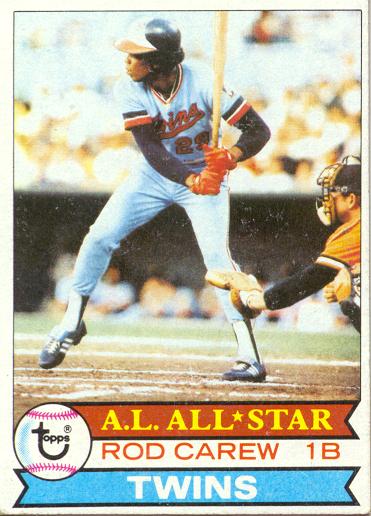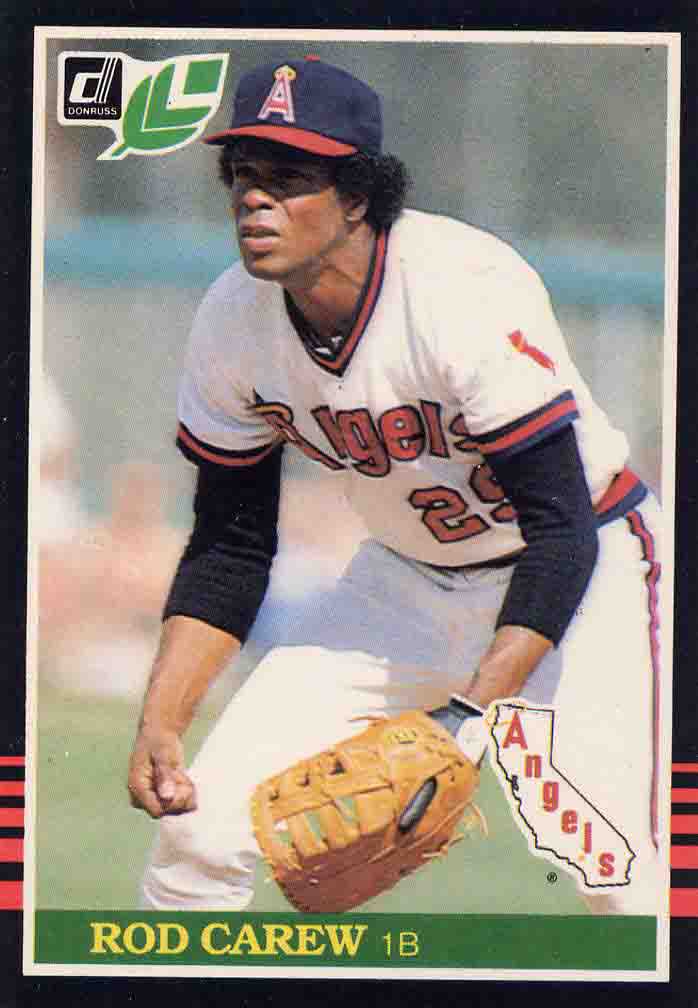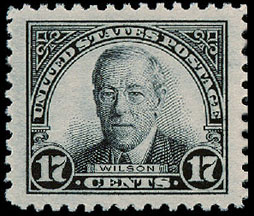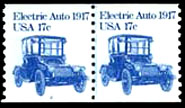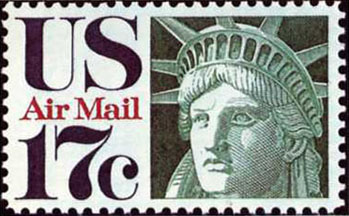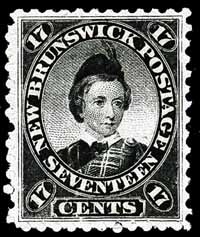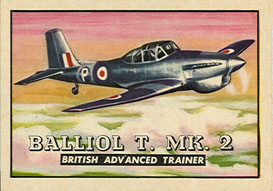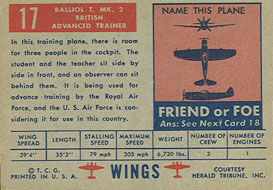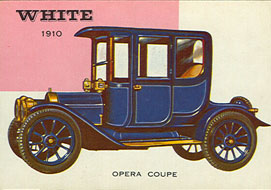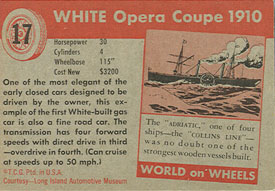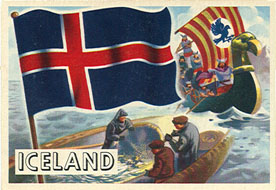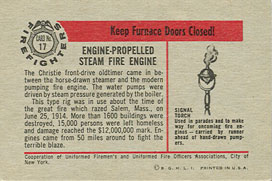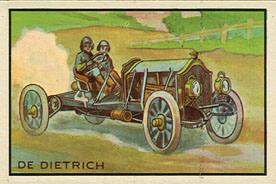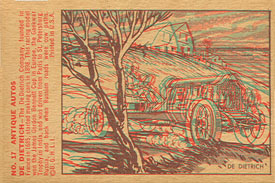|
On the Number 17
| |||||||||
|
17 in Mathematics
| |||||||||
| 1) | The 9th odd number = 17 | ||||||||
| 2) | The 7th prime number: 2, 3, 5, 7, 11, 13, 17 | ||||||||
| 3) | The 3rd Fermat prime: 3, 5, 17, 257, 65537 | ||||||||
| 4) | The 4th Eisenstein prime: 2, 5, 11, 17, 23, 29, 41, 47, 53, 59 | ||||||||
| 5) | Sum of the first four prime numbers = 2 + 3 + 5 + 7 = 17 | ||||||||
| 6) | 34/2 = 17; 51/3 = 17; 68/4 = 17 | ||||||||
| 7) | Sum of the 1st & 4th square numbers = 12 + 42 = 1 + 16 = 17 | ||||||||
| 8) | Sum of the 4th odd number & 5th even number = 7 + 10 = 17 | ||||||||
| 9) |
Sum of the 3rd & 4th composite numbers = 8 + 9 = 17 Sum of the 3rd composite & 3rd square numbers = 8 + 9 = 17 Sum of the 2nd cube & 3rd square numbers = 8 + 9 = 17 | ||||||||
| 10) |
Sum of the 1st perfect number
& 5th prime number = 6 + 11 = 17 | ||||||||
| 11) |
Sum of the 1st abundant number
& 3rd prime number = 12 + 5 = 17 | ||||||||
| 12) | Sum of 1st, 3rd, & 4th triangular numbers = 1 + 6 + 10 = 17 | ||||||||
| 13) |
Sum of the 1st, 4th, & 7th Fibonacci numbers
= 1 + 3 + 13 = 17 (Leonardo Pisano Fibonacci, 1170-1250) | ||||||||
| 14) |
Sum of the 1st, 2nd, & 5th lucky numbers
= 1 + 3 + 13 = 17 | ||||||||
| 15) |
17 appears in the 8th set of
amicable numbers,
17,296 and 18,416 Also in the 19th set of amicable numbers: 171,856 and 176,336 More on Amicable Numbers | ||||||||
| 16) |
17 appears twice in the 9th perfect number as the 16th-17th digits & the 35th-36 digits: 2658455991569831744654692615953842176 List of 15 Perfect Numbers | ||||||||
| 17) |
The shortest side of the 8th primitive Pythagorean triangle, 17-144-145 is 17 | ||||||||
| 18) | Square root of 17 = 4.123105626 | ||||||||
| 19) | Cube root of 17 = 2.571281591 | ||||||||
| 20) | ln 17 = 2.833213344 (natural log to the base e) | ||||||||
| 21) | log 17 = 1.230448921 (logarithm to the base 10) | ||||||||
| 22) |
Sin 17o = 0.121869343 Cos 17o = 0.956304756 Tan 17o = 0.305730681 | ||||||||
| 23) |
1/17 expressed as a decimal = 0.058823529 | ||||||||
| 24) |
The 95th & 96th digits of pi, π = 17 The 138th & 139th digits of pi, π = 17 The 155th & 156th digits of pi, π = 17 | ||||||||
| 25) |
The 35th & 36th digits of
phi, φ = 17 The 43rd & 44th digits of phi, φ = 17 Phi or φ = 1.61803398874989484820 is a transcendental number, also called the Golden Ratio (or Golden number). Leonardo da Vinci (1452-1519) first called it the sectio aurea, (Latin for the golden section) and related it to human anatomy. Ratios may be found in the Pyramids of Giza & the Greek Parthenon. | ||||||||
| 26) |
The 161st & 162nd digits of e = 17 The 173rd & 174th digits of e = 17 (e = 2.7182818284 5904523536...) | ||||||||
| 27) |
Binary number for 29 = 10001 (Decimal & Binary Equivalence; Program for conversion) | ||||||||
| 28) |
ASCII value for 17 = DC1 (Hexadecimal # & ASCII Code Chart) | ||||||||
| 29) |
Hexadecimal number for 17 = 11 (Hexadecimal # & ASCII Code Chart) | ||||||||
| 30) |
Octal number for 29 = 021 (Octal #, Hexadecimal #, & ASCII Code Chart) | ||||||||
| 31) | The Greek-based numeric prefix heptadeca- means 17. | ||||||||
| 32) | The Latin-based numeric prefix septendeci- means 17. | ||||||||
| 33) | heptakaidecagon is a polygon with 17 sides. | ||||||||
| 34) | heptakaidecahedron is a polyhedron with 17 faces. | ||||||||
| 35) | septendecennial means a 17 year anniversary or recurring every 17 years. | ||||||||
| 36) | The Roman numeral for 17 is XVII. | ||||||||
| 37) |
 Shí Qi
is the Chinese ideograph for 17.
Shí Qi
is the Chinese ideograph for 17.
| ||||||||
| 38) |
 is the
Babylonian number for 17.
is the
Babylonian number for 17.
| ||||||||
| 39) |
 is the
Mayan number for 17.
is the
Mayan number for 17.
| ||||||||
| 40) |
29 in different languages: Dutch: zeventien, French: dix-sept, German: siebzehn, Hungarian: tizenhét, Italian: diciassette, Spanish: diecisiete, Swahili: kumi na saba, Swedish: sjutton | ||||||||
|
17 in Science
| |||||||||
| 48) | Synodic month: Number of days in a lunar cycle = 29.53059 | ||||||||
| 49) | Number of days in a "defective" Jewish lunar month = 29 | ||||||||
| 50) | Number of days in an even Macedonian calendar month = 29 | ||||||||
| 51) | Number of years that Saturn makes a solar revolution = 29.46 | ||||||||
| 52) |
The
human skull has 29 bones (face 14, cranium 8, ear 6, top of throat 1). Some sources consider 22 bones in the human skull, excluding the ears and the hyoid bone. | ||||||||
| 53) | According the Gray's Anatomy, the human intestinal canal is 29 feet long. | ||||||||
| 54) |
Atomic Number of
Chlorine (Cl) = 17 (17 protons & 17 electrons) Chlorine is a greenish yellow gas which combines directly with nearly all elements. Chlorine is a respiratory irritant. The gas irritates the mucous membranes and the liquid burns the skin. It was used as a war gas in 1915. It is not found in a free state in nature, but is found commonly as NaCl (solid or seawater). | ||||||||
| 55) |
Average Molecular Weight of Air = 29 (28.96) | ||||||||
| 56) |
Molecular Weight of Lithium oxide,
Li2O = 29.88 | ||||||||
| 57) | Compounds whose melting point = 29oC: Calcium chloride, CaCl22O, MP = 29.92oC Lithium nitrate, LiNO32O, MP = 29.88oC Chloro benzyl chloride, ClC6H4-CH2Cl, MP = 29oC Chloro o-toluidine (m), Cl-C6H3(CH3)NH2, MP = 29-30oC Diethylene dilaurate, (C11H23COSUB>2C2H4)2, MP = 28-30oC Nitro styrene (p), NO2-C6H4-CH=CH2, MP = 29oC [Norbert A. Lange, Handbook of Chemistry, Sandusky, Ohio (1952)] | ||||||||
| 58) |
The 29th amino acid in the 141-residue alpha-chain of Human Hemoglobin is Leucine (L) The 29th amino acid in the 146-residue beta-chain of Human Hemoglobin is Glycine (G) Single-Letter Amino Acid Code Alpha-chain sequence of human hemoglobin: VLSPADKTNVKAAWGKVGAHAGEYGAEALERMFLSFPTTKTYFPHFDLSH GSAQVKGHGKKVADALTNAVAHVDDMPNALSALSDLHAHKLRVDPVNFKL LSHCLLVTLAAHLPAEFTPAVHASLDKFLASVSTVLTSKYR Beta-chain sequence of human hemoglobin: VHLTPEEKSAVTALWGKVNVDEVGGEALGRLLVVYPWTQRFFESFGDLST PDAVMGNPKVKAHGKKVLGAFSDGLAHLDNLKGTFATLSELHCDKLHVDP ENFRLLGNVLVCVLAHHFGKEFTPPVQAAYQKVVAGVANALAHKYH | ||||||||
| 59) |
"Haemoglobin Lufkin: β29 (B11) Gly replaced by Asp. An unstable hemoglobin variant involving an internal amino acid residue." R.M. Schmidt, K.C. Bechtel, M.H. Johnson, B.L. Therrell, Jr. W.F. Moo-Penn, Hemoglobin Vol. 1, 799-814 (1977) Hemoglobin Lufkin was found in a Black-American family. Structural analysis of the abnormal hemoglobin indicates a substitution of aspartic acid for glycine at position 29 in the beta chain. Marked instability of the variant hemoglobin is demonstrated by the rapid formation of inclusion bodies upon exposure of the red cells to redox dyes and by the large percentage of precipitated hemoglobin at 65 oC. The oxygen affinity, the Bohr effect, and the degree of cooperativity of Hb Lufkin and Hb A are similar over the physiologic pH range. However, at acid pH the oxygen affinity of the variant is increased. Unlike other variants in the B helix, Hb Lufkin is not associated with methemoglobinemia. | ||||||||
| 60) |
The 29th amino acid in the 153-residue sequence of
sperm whale myoglobin is Leucine (L) [A.B. Edmundson, Nature 205, 883-887 (1965)] | ||||||||
| 61) |
The 29th amino acid in the 124-residue enzyme
Bovine Ribonuclease is Methionine (M). It is next to Glutamine-28 and Methione-30. [C. H. W. Hirs, S. Moore, and W. H. Stein, J. Biol. Chem. 235, 633 (1960)] | ||||||||
| 62) |
The 29th amino acid in the 32-residue sequence of
human calcitonin is Valine (V). In salmon calcitonin, the 29th residue is Serine (S). In bovine and porcine calcitonin, the 29th residue is Proline (P). [H.D. Niall, et. al., Proc. Natl. Acad. Sci. 64, 771-778 (1969)] Sequence alignment of calcitonin by Margaret O. Dayhoff [Atlas of Protein Sequence and Structure, Vol. 5, Suppl. 3 (1978), p. 149] shows conservation of Gly-28 in all 9 species— human, bovine, sheep, pig, rat, eel, and salmon 1-3. European J. Biochem. 269, 780-791 (2002) | ||||||||
| 63) |
Glucagon is a 29 amino acid peptide hormone liberated in the a cells of the islets of Langerhans. The 29th amino acid of glucagon is Threonine (T) Chou & Fasman's protein conformation prediction showed that glucagon 19-29 region to have both α-helical and β-structural potential. Biochemistry, Vol. 14, 2536-2541 (1975). | ||||||||
| 64) |
β-Turn Frequencies in 29 proteins: [from Table VIII (p. 71) of P.Y. Chou & G.D. Fasman, Advances in Enzymology 47, 45-148 (1978)] [Peter Y. Chou & Gerald D. Fasman, "β-Turn in Proteins", Journal of Molecular Biology, Vol. 115, 135-175 (1977)] Abstract: The X-ray atomic co-ordinates from 29 proteins of known sequence and structure were utilized to elucidate 459 β-turns in regions of chain reversals. | ||||||||
| 65) |
An automated computer prediction of the chain reversal regions of globular proteins was published using bend frequencies and β-turn conformational parameters (Pt) determined from 408 β-turns in 29 proteins calculated from x-ray atomic coordinates. P. Y. Chou & G. D. Fasman, "Prediction of β-Turns" Biophysical Journal, Vol. 26, 367-383 (1979) Using the bend frequencies based on 29 proteins β-turn probability profiles were calculated for the C-peptides of 10 mammalian proinsulins, for 7 proteinase inhibitors, and for 12 species of pancreatic ribonucleases. Results suggest that chain reversal regions play an essential role in keeping the active structural domains in hormones and enzymes intact for their specific biological function. P. Y. Chou & G. D. Fasman, "Conservation of chain reversal regions in proteins" Biophysical Journal, Vol. 26, 385-399 (1979) | ||||||||
| |||||||||
| |||||||||
| 70) |
 Messier object M29
Messier object M29M29 is a rather coarse and less impressive cluster, situated in the highly crowded area of Milky Way near Gamma Cygni, at a distance of 4,000 light years from the Earth. Open cluster M29 was discovered by Charles Messier, who cataloged it on July 29, 1764. The four brightest stars form a quadrilateral, and another three, a triangle north of them. | ||||||||
| 71) |
The New General Catalog (NGC)
is a listing of nearly 8,000 non-stellar objects, such as star clusters, nebulae, and galaxies, compiled by J.L.E. Dreyer (1887). NGC 29 is an elliptical galaxy in the constellation Andromeda. (Image) | ||||||||
| 72) |
29 Amphitrite is one of the largest Main belt asteroids. It has a relatively bright surface and a composition of silicates rock and iron-nickel metals. Amphitrite was discovered by Albert Marth on March 1, 1854. It was his only asteroid discovery. It is named after Amphitrite, a sea goddess in Greek mythology. Its diameter is 1212.2 km, rotation period of 5.39 hours, and orbital period of 4.08 years. "Asteroid 29 Amphitrite— Surface Composition and Spectral Variation" by J.F. Bell, et. al., Astron. Soc. Pacific Pub. 97, 892 (Oct. 1985) | ||||||||
| 73) |
Volume 29 of
Nature (1883)— A Weekly Illustrated Journal of Science was published by Macmillan & Co., London (November 1, 1883 to April 24, 1884), pp. 1-616 Wordsworth epigraph on cover: "To the solid ground Of Nature trusts the mind which builds for aye." Four interesting articles in Nature XXIX: 1) J. Norman Lockyer, "Movements of the Earth: II. Measurement of Time", Nature XXIX, 65-69 (Nov. 15, 1883): It has been shown how, by the application of geometrical and optical principles, the measurement of angular space has been carried cown to the 1/100th of a second of arc, such a quantity being 1/129,600,000th part of an entire circumference, and when such an accuracy as this has been attained, and the altitude or the azimuth of the sun, or moon, or any other heavenly body can be correctly stated with this exactitude, it will be seen how much better off in the way of defining positions is the modern astronomer than was Hipparchus with his 1/3rd, and Tycho Brahe with his 1/4th of a degree... The next thing to be done, is to see how far we moderns have got in another kind of measurement, no longer the measurement of arc— the measurement of angular distance— but the measurement of time... Time can be divided down to the 1/10th of a second, or to the 864,000th part of a day, not only by a clock, but also by this chronometer... In the Book of Job, there is a reference to the constellation of Orion, also called Charles's Wain, or the Great Bear, known to the ancients. If the stars were very close to us the smallest motion either of earth or star would at once change their apparent positions, and would prevent this fixity of appearance, and the skies would be filled, not with the constellations with which we are so familiar, but with noew and ever-changing clusters of stars. This constancy of the constellations, not only from century to century, but from era to era, clearly proves that the stars of which they are made up must be at an infinite distance from the earth. [Measure changes in star's positions over time.] 2) William Thomson, (Lord Kelvin) "Scientific Worthies: XXIII— Sir Charles William Siemens (Born April 4, 1823; Died Nov. 19, 1883)" Nature XXIX, 97-99 (November 29, 1883), 250-254 (July 12, 1883), 274-278 (July 19, 1883) The death of Sir William Siemens, coming as it did so suddenly and unexpectedly, has been felt as a severe blow and grief through a far wider circle than that of his personal friends... William Siemens had the great characteristic common to all men who have left their mark on the world, the perfervidum ingeniium, in which thought leads to instant action. When he was only 20 years old he came to England with his brother Werner, to realise an invention for electo-gilding. A year later he invented the chronometric governor, and later, the watermeter. They later invented the Siemens armature, and their achievements in Atlantic cable-laying... In private life Sir William Siemens, with his lively bright intelligence always present and eager to give pleasure and benefit to those around him, was a most lovable man, singularly unselfish and full of kind thought and care for others. The writer of the present article has for nearly a quarter of a century had the happiness of personal friendship with him. The occasions of meeting him, more frequent of late years, and more and more frequent to the very end, are among the happiest of recollections. The thought that they can now live only in memory is too full of grief to find expression in words. 3) C. Piazzi Smyth, "The Remarkable Sunsets" Nature XXIX, 149-153 (Dec. 13, 1883): On December 3 [1883], the reds were so powerful at certain times, and the air so clear between me and them, that the young crescent moon, though low down in the sky, shone by contrast to the scarlet cloudlets aroud it with a sort of supernatural lustre of blue silver; while the gaslights under the same constrast, though in reality a gross beery brown in colour, appeared of a delicate sulphur, almost greenish, yellow. Those clouds, therefore, were so red in consequence of something that had happened to the sunlight illumining them which had not happened to that illumining the moon... But the sunset of December 5 was very different. In the course of the evening there were two or three distinct atempts, as it were, for the clouds to assume red hues, but they lasted for only a few seconds each; and though some aspects of the scene were very fine pictorially, it had to be classed as a "yellow sunset"... this may yet have something to do with the green and blue suns seen in India last September, and they with the great volcanic explosions in Java last August, so destructive of human life! 4) E. Metzger, "Gleanings from the Reports Concerning the Eruption of Krakatoa" Nature XXIX, 240-244 (Jan. 10, 1884): On the Island of Bali strong detonations were heard in the morning of August 26 [1883]... On borad the Charles Bal at 4:15 an eruption at the east of Krakatoa was observed; the masses which were driven forth to the east had the apperance of a furious squall... At 5 pm sky darkening, detonations stronger, pumice-stones pouring down, rather big pieces... Waves at Anjer (August 27, 9 am) estimated to be 135 feet (about 41 metres)... Sibessie was from the sea to the top buried under ashes (all people killed)... Up to November 1, they counted 32,635 persons killed by the eruption. 5) M.C. van Doorn, officer in command of H.M. ship Hydrograaf, "The Eruption of Krakatoa" Nature XXIX, 268-269 (Jan. 17, 1884): Sixteen volcanoes now working between the spot where Krakatoa was before and Sebesie. Such was one of the first reports which was sent by cable to Singapore, and which we heard at Pontianak. Krakatoa has not entirely disappeared, while, till now, no new volcanoes are visible in the neighborhood... The northern part of the island has entirely disappeared... Where was land before, there is now no bottom to be found; at least we could not fathom it with lines of 200 fathoms (360 metres) long... Lang Island formerly covered by a luxurious vegetation, is now buried under a mass of pumice-stone, and appear like shapeless clods of burst clay... Sebesie is also covered with ashes up to the top— 859 metres— which appear like a grayish-yellow cloth. Krakatoa Eruption of August 26, 1883 | ||||||||
| 74) | Volume 29 of
Science (1908)— a Weekly Journal devoted to the Advancement of Science was published by The Science Press, New York (January-June 1909), pp. 1-1014 Interesting articles in this volume: 1) Edward L. Nichols, "Science and the Practical Problems of the Future" Science XXIX, 1-10 (January 1, 1909) The end of the world has long been a favorite subject of speculation. The ancients and our forefathers of the middle ages were pleased to imagine some sudden final disaster; as by fire. Science in our own day furnishes a basis for a more definite forecast... Unchecked wastefulness as in the extermination of the bison, in the destruction of forests, in the exhaustion of the soil, in the disappearance of fish from our coasts and streams, in the pouring into the air of an incredible amount of unused fuel from coke ovens must cease or our ruthless exploitation wil bring disaster on generations soon to come... World power in the near future is to be a question of knowledge— not of battleships— and what is now spent on armaments is to be devoted to its pursuits. 2) Josiah Royce, "The American College and Life" Science XXIX, 401-407 (March 12, 1909) When I observe that a student is inattentive, I try to interest him. When he is wilful, I try to get past his wilfulness as I can. I do not know what, as a teacher, I accomplish. I simply try my best... There is a place in the college for the great teacher with a mind like that of Socrates, the prince of teachers, produces indirectedly, by acting as the midwife, and by delivering others of the ideas with which their own minds are pregnant... We want teaching and investigation to become more and more what they ought to be— one and inseparable. 3) Frederic S. Lee, "Physical Exercise from the Standpoint of Physiology" Science XXIX, 555--527 (April 2, 1909) Mythologists tell us that Aesculapius, the god of healing, was slain by a thunderbolt from Zeus because of complaints which had reached that deity that Aesculapaius had become so skilful in his art that Hades was fast being depopulated. His tragic end, however, did not deter his courageous daughter, Hygeia, the goddess of health. The aim of her cult is to bring to, and maintain at, its highest efficiency the human organic machine... Physiology teaches that the fatigue of one tissue from over-use means the fatigue of all tissues... it is the teaching of common sense to avoid physical excess. Common-sense hygiene should have its place in a liberal education. 4) Victor C. Vaughan, "The Physical Basis of Life" Science XXIX, 799-805 (May 21, 1909) The cell may be regarded as the morphological unit of life, but form in and of itself, and as recognized by the eye, is not essential to the manifestations of life. We know no life apart from matter, and matter and energy are the only things that we do know... The only difference between living and non-living matter is that within the former there is constant and rhythmic metabolism, while in the latter no such process occurs. Metabolism, the one characteristic phenomenon of living matter, involves intramolecular change; consequently the molecule, and not the cell, is the unit of life... Sensibility, or the capability of responding to stimuli, is, as Claude Bernard said, to a certain extent the starting-point of life; it is a primary phenomenon and from it all others, physiological, intellectual and moral develop... Since nothing comes from nothing, the basis of psychical action must lie in the physiolo-chemical elements of the organism. | ||||||||
| 75) |
 B-29 Superfortress:
Once the largest U.S. Air Force bomber,
B-29 Superfortress:
Once the largest U.S. Air Force bomber,it is now classified as a medium bomber. It can carry five tons of bombs to a target 2000 miles away, drop the bombs, then return to its base non-stop. It can also refuel in midair. The first one built made its maiden flight on Sept. 21, 1942. The second atomic bomb was dropped from a B-29 on Nagasaki on August 9, 1945. Wing span: 141'3"; Length: 99 feet; Height: 27'9"; Maximum speed: 357 mph; Weight: 140,000 lbs. B-29 Superfortress appears as Card #51 of Topps Wings: Friend or Foe (1952). | ||||||||
| 76) |
The U.S. T-29 tank was developed in March 1944 in order to improve upon what became the M-26 Pershing. The 62 ton T-29 mounted a 105-mm gun with a rammer to help the crew with the heavy ammunition. The T-29 featured a stereoscopic rangefinder projecting from both sides of the turret. Because the ammunition was heavy, it was in two parts, and two loaders were needed. On the T-29, armor ranged from 4 inches on the hull to 11" on the mantlet, and a V-12 powered the tank. Vehicle speeds were 18-1/2 mph. | ||||||||
|
17 in Mythology & History
| |||||||||
| 77) |
29 Symbolism: Its potency is indistinct. One whose name corresponds to the number is extravagant, nervous, religious, suspicious, and in danger from heights and water. Physical weak spots: brain and nerves. Cabalistic traits: anxiety, doubting, virtuous, zelous; in low form: fanatic, hypocritical. In Sumer a 29th day in a month was one of sack-cloth and ashes, suggesting mourning. — Gertrude Jobes, Dictionary of Mythology, Folklore and Symbols Scarecrow Press, New York, 1962, Part 2, p. 1613 | ||||||||
| 78) |
There are 32 Paths of Wisdom in the
Sepher Yetzirah or
Book of Formation (200 AD). The 29th Path is the Corporeal Intelligence, so called because it forms every body which is, formed beneath the whole set of worlds and the increment of them. Isidore Kozminsky, Numbers: Their Meaning and Magic, Rider, London, 1912, p. 48 Order of the Golden Dawn: The 29th Path need to be balanced with intellect and reason. | ||||||||
| 79) |
Sabian symbols Aries 29o: A celestial choir has arisen to sing. Taurus 29o: Capability— Two cobblers working at a table. Gemini 29o: Quickening— The first mockingbird in spring. Virgo 29o: A Man is Gaining Secret Knowledge from an Ancient Scroll he is Reading. Dan Rudhyar, An Astrological Mandala: The Cycle of Transformations and its 360 Symbolic Phases, Vintage, New York (1973), p. 286 (Image) | ||||||||
| 80) |
 There are 36 Angel Cards
There are 36 Angel Cardsat the website Portrait Corner. Angel Card 17 is the Angel of Forgiveness. This angel is seen holding the lily of purity with which it blesses those asking for forgiveness. Brotherhood is a natural consequence when we forgive others. Forgiveness means we release the tears of past hurts and the anger of past resentment, to line with the love of the angels in the here and now. | ||||||||
| 81) |
The 17th day of the year =
January 17 [January 17 Birthdays: Benjamin Franklin (1706-1790); Anne Brontë (1820-1849); Mack Sennett (1880-1960); Glenn L. Martn (1886-1955); Robert M. Hutchins (1899-1977); Nora Kaye (1920-1987); Betty White (born 1/17/1922); Muhammad Ali (1942-2016)] | ||||||||
| 82) |
There are 29 days in February during a leap year—
February 29 [February 29 Birthdays: John Philip Holland (1840-1914); Gioacchino Rossini (1792-1868); Herman Hollerith (1860-1929); Augusta Savage (1892-1962); Jimmy Dorsey (1904-1957)] | ||||||||
| 83) |
Events in 17 B.C.— • Ode Carmen Saeculare by the Roman poet-critic Horace, 47, is sung by a chorus of youths and maidens at a great festival of games put on by the emperor Augustus. Horace is well known for his Odes I.ix ["Seize the day", carpe diem], his Satires II.iii ["There is a certain method in his madness."], and his Epistles I.ii ["Well begun is half done."] James Trager (Ed.), The People's Chronology (1979), p. 34 • March 1— Horace writes the ode Occidit Daci Cotisonis agmen • Gaius Julius Caesar Octavianus becomes Roman Consul for the fifth time. His partner is Sextus Appuleius. He was granted the title of imperator, and for the third time in Roman history the doors of the Temple of Janus were closed, signaling peace. (Wikipedia: 29 BC) | ||||||||
| 84) |
Events in 17 A.D.— • Rome's Emperor Tiberus sends his nephew Germanicus to install a new king in Armenia. • Cappadocia and Commagene become a Roman province following the death of their king. • A tax on slaveholding is enacted in China, where slaves do most of the menial work as they do in Rome. • Seven regional Chinese commissions are directed to establish annual high, low, and mean price levels for staples and to buy surplus goods at cost, but merchants and capitalists employed by the emperor Wang Mang as administrators will provoke revolts. James Trager (Ed.), The People's Chronology (1979), pp. 35-36 • Romans captured Sofia. • Death of Livia Drusilla (58 BC-29 AD), wife of Augustus, and the most powerful woman in Roman history, acting several times as regent and being Augustus' faithful advisor. She was also mother of the Emperor Tiberius. (Fact-index.com: 29 AD) | ||||||||
| 85) |
 17th President
17th Presidentof the United States is Andrew Johnson (1808-1875) who served (1865-1869) after the assassination of President Lincoln. Andrew Johnson was on the rose red 17¢ postage stamp (Scott# 822) issued on Oct. 27, 1938 in the Presidential Series. | ||||||||
| 86) | 17th State to enter the Union is Ohio (March 1, 1803) | ||||||||
| 87) |
At Age 29: Prince Siddharta (563 BC-486 BC), later the Buddha, leaves his wife and newborn son, to become a penniless wandering monk. St. Francis of Assisi (1181-1226), writes Friars Minor (1210) the beginning of the Franciscans Order in Italy. Charles II (1630-1685), becomes British King (May 29, 1660) at the Restoration. He was 18 when his father King Charles I was executed. Robert Adam (1728-1792), considered Scotland's most famous architect, surveys the Emperor Diocletian's palace at Split (1757) in only 5 weeks— starting his own distinctive style incorporating light, color, and detailed ornamentation. James Watt (1736-1819), Scottish inventor, has a sudden insight for the design of the steam engine (1765). In two days, he produces almost all the basic principles of the future power source. Wolfgang Amadeus Mozart (1756-1791), composes Piano Concerto in C Major, K.467 (1785). This piece was later used as the theme music in the film Elvira Madigan (1967) Eli Whitney (1765-1825), American inventor, patents the cotton gin (1794) which mechanically separates cotton seeds from the fiber. Percy Bysshe Shelley (1792-1822), British poet, dies on July 8, 1822 from drowning in a sailing accident in the Mediterranean. His body is found with a volume of Keats in one pocket, and of Sophocles in the other. Charles Babbage (1792-1871), British mathematician, makes his first attempt to invent a calculating machine (1822). Dies at 77 with this pioneering work in computers. Henry Mayhew (1812-1887), British journalist, and one of the founders of Punch magazine (1841). Richard Wagner (1813-1883), has the first performance of his opera Rienzi (1842) and of The Flying Dutchman. The score of Rienzi is finished in debtors' prison as Wagner is plagued with debt for most of his life. Emily Brontë (1818-1898), British novelist, publishes Wuthering Heights (1847), but dies a year later. Anne Brontë dies at 29, having published novels at 27 and 29. Charlotte Brontë publishes Jane Eyre at 31, but dies at 39. Their brother, Branwell Brontë, dies at 31. Their fater, Ulsterman Reverend Patrick Brontë (1777-1861), survives them all, dying at 85. Karl Marx (1818-1883)), German philosopher & political economist publishes The Communist Manifesto (Feb. 21, 1848) with Friedrich Engels (age 27). Alfred Waterhouse (1830-1905), British architect, wins competition for the huge Manchester Assizes (1859), with a design in Venetian Gothic. Lawrence Alma-Tadema (1836-1912), Dutch-born painter of the Victorian era, develops his lifelong style around 1865— sunny classical buildings of marble filled with luscious figures, draped and undraped. Alexander Graham Bell (1847-1922), Scottish/U.S. inventor, patents the telephone (1876). The first message ever sent by telephone is "Mr. Watson, come here. I want you." On March 7, 1876, Bell was issued patent number 174,465. Giuseppe Sacconi (1854-1905), Italian architect, won a contest of projects for the Monument of Victor Emanuel II (Rome, Piazza Venezia) in 1884. The monument was built 1885-1911, and completed after Sacconi's death. James Elroy Flecker (1884-1915), British poet, publishes The Golden Journey to Samarkand (1913), but he dies at 30 from tuberculosis. He also wrote two novels. Louis B. Mayer (1885-1957), U.S. film producer, with Samuel Goldwyn formed MGM, Metro-Goldwyn-Mayer (1924). As studio boss, he built MGM into the most financially successful motion picture studio in the world. Bruce Barton (1886-1967), U.S. advertising executive, founder of Batten, Barton, Durstine & Osborn (BBDO) in 1918. Wrote The Man Nobody Knows (1925) depicting Jesus Christ as a successful salesman, publicist and role model or the modern businessman. Sigmund Romberg (1887-1951), Jewish composer, writes operatta The Desert Song (1926). Ludwig Wittgenstein (1889-1951), Austrian philosopher, publishes Tractatus Logico-Philosophicus (1918) John B. Kelly (1889-1960), U.S. oarsman wins 126 consecutive races in 1919-1920, a record that includes a gold medal at the 1920 Olympics in Antwerp. His daughter Grace Kelly is born (Nov. 12, 1929) when he is 38. Agatha Christie (1890-1976), British novelist, publishes her first book The Mysterious Affair at Styles (1920). She had learned about poisons while working in a hospital dispensary. She wrote over 80 novels and plays. Frederick Banting (1891-1941), Canadian chemist, discovers insulin (1921) together with Charles Best (age 22). Awarded Nobel Prize in Medicine (1923). Dorothy Parker (1893-1967), American writer & poet, slashes her wrists, but survives (1923). At 32, her first book of poems Enough Rope makes her rich & famous. She's best known for her caustic wit, wisecracks, and sharp eye for urban foibles. F. Scott Fitzgerald (1896-1940), American novelist, publishes The Great Gatsby (1925). Ernest Lawrence (1901-1958), U.S. physicist, invents the cyclotron (1930). Awarded 1939 Nobel Prize in Physics. W. H. Auden (1907-1973), British poet & critic, writes screenplay for Night Mail (1936), the film on the overnight mail train between London and Scotland. Lyndon B. Johnson (1908-1973), U.S. President, becomes Congressman (1937). Douglas Fairbanks (1909-2000), American actor, stars in The Prisoner of Zenda (1937). Errol Flynn (1909-1959), American actor, stars in The Adventures of Robin Hood (1938). Alan Ladd (1913-1964), U.S. actor, performance in This Gun for Hire (1942) makes him a star. John F. Kennedy (1917-1963), U.S. President, becomes Congressman (1947). Jack Kerouac (1922-1969), American novelist & poet, writes On the Road in 3 weeks (1951). Sid Caesar (born Sept. 8, 1922), U.S. comic actor & writer has hit TV show Your Show of Shows (1951) with Imogen Coca (43). At 35, he employs writers such as Woody Allen (22) & Neil Simon (30). Marlon Brando (1924-2004), American actor, stars in The Wild Ones (1953). Billy Halley (1925-1981), U.S. musician, has hit "Rock Around the Clock" (1955). Marilyn Monroe (1926-1962), American actress, stars in The Seven-Year Itch (1955). Clint Eastwood (b. May 31, 1930), U.S. actor, stars in Rawhide on TV (1959) for 7 years. Delphine Seyrig (1932-1990), French actress, stars in Last Year in Marienbad (1961). François Truffaut (1932-1984), French film director, directs Jules et Jim (1961). The film starred Jeanne Moreau, Oskar Werner, and Henri Serre. Elizabeth Taylor (b. Feb. 27, 1932), American actress, stars in Butterfield 8 (1961). She was awarded an Oscar as Best Actress for this film. Roman Polanski (b. Aug. 18, 1933), French film director, directs Knife in the Water (1962). Glen Campbell (b. April 22, 1936), U.S. singer, has hit "By the Time I Get to Phoenix" (1967). Claude Lelouch (b. Oct. 30, 1937), French film director, directs A Man and a Woman (1966). [Sources: World Almanac Book of Who (1980); Jeremy Baker, Tolstoy's Bicycle (1982), pp. 179-185; Web Links] | ||||||||
| 88) |
.jpg) Stanford Bronze Plaque 17
Stanford Bronze Plaque 17on the ground 20 yards to the right of Stanford University's Memorial Church is dedicated to the Class of 1917. It is to the left of Building 60 (Archaeology Center). The first graduating class at Stanford was 1892. In 1980, Stanford Provost Don Kennedy strolled around the Inner Quad and calculated that it would take 512 years for the bronze class plaques embedded in the walkways to circle the entire area ending with the Class of 2403. | ||||||||
|
17 in Geography
| |||||||||
| 89) |
United States Cities located at 29o latitude: Daytona Beach, Florida: 29o 12' N latitude & 81o 1' W longitude Gainesville, Florida: 29o 39' N latitude & 82o 19' W longitude Galveston, Texas: 29o 18' N latitude & 94o 47' W longitude Houston, Texas: 29o 45' N latitude & 95o 21' W longitude New Orleans, Louisiana: 29o 57' N latitude & 90o 4' W longitude San Antonio, Texas: 29o 25' N latitude & 98o 29' W longitude The World Almanac and Book of Facts (2005), pp. 497-498 | ||||||||
| 90) |
Cities located at 29o latitude: Chongquing, China: 29o 33' N latitude & 106o 33' E longitude Cairo, Egypt: 29o 52' N latitude & 31o 20' E longitude Kuwait, Kuwait: 29o 20' N latitude & 48o 0' E longitude Maseru, Lesotho: 29o 19' N latitude & 27o 29' E longitude Shiraz, Iran: 29o 38' N latitude & 52o 34' E longitude Sidi Ifni, Morocco: 29o 24' N latitude & 10o 12' W longitude | ||||||||
| 91) |
Cities located at 29o longitude: Istanbul, Turkey: 40o 58' N latitude & 28o 50' E longitude | ||||||||
| 92) |
The Congo River is 2900 miles (4,670 km) long. It is the largest river in Western Central Africa, the 2nd longest in Africa (after the Nile) and 8th longest river in the world. The World Almanac and Book of Facts (2005), p. 499 | ||||||||
| 93) |
29 appears in the code for
international direct dial
phone calls for Saint Helena (290), Eritrea (291), Aruba (297), Faroe Islands (298), Greenland (299), and Benin (229). | ||||||||
| 94) |
Twentynine Palms is a town in California that is the home of Joshua Tree National Park. It is the gateway to scenic Mojave Desert. Population: 25,171 (Jan. 1, 2003), Male 65%, Female 35% The 29 Palms Art Gallery is hosted by the 29 Palms Artists' Guild, founded in 1952. Address: 74055 Cottonwood Drive, 29 Palms, CA 92277 | ||||||||
| 95) |
Livery Stable
waslocated at 109 West 17th Street, New York City. It was built in 1869 by Thomas Lord (1794-1879). The building was a livery stable kept by Patrick Logan from approximately 1900-1905. rom 1918-1931 109 W. 17th St. was occupied by the Alliance Paper & Twine Co. Then it was taken over by Charles F. Wilson Inc., a printer and dealer in printers' supplies who remained here until some time in the 1960s. | ||||||||
| 96) |
17th Arrondissement Paris: The 17th is predominantly a high-end residential and commercial district. The south is a trendy area with good commerce and its large boulevards and traditional architecture gives it an elegant feel. The Ternes and Poncelet district is a lively market area for the local community. Centrally, the 17th benefits from the Monceau Park and the buzzing Levis café and commercial district, which gives way to the leafy calm avenues at the outer rim. Le Maraicher, vegetable market, Rue Poncelet (Official Site: Mairie du 17e) | ||||||||
| 97) |
29th Street Repertory Off-Broadway Theatre
based in NYC, in the past has featuring work from or by Edward Norton and Charles Bukowski. Address: 212 W 29th Street, #2, New York, NY 10001 (Video) | ||||||||
| 98) |
Georgetown Suites Harbour
is an all suite hotel located in the heart of historic Georgetown Address: 1000 29th Street, NW, Washington DC 20007 | ||||||||
| 99) |
Russian American Building 29
in Sitka, Alaska, has been designated as a National Historic Landmark. A finely crafted, vernacular log building covered with siding remaining from Sitka's first years as a seat of government in the period following the purchase of Alaska by the U.S. in 1867. | ||||||||
| 100) | Building 29 is W.K. Kellogg Arabian Horse Center on the Cal Poly Pomona Campus. | ||||||||
| 101) |
The glass faces of the Cira Centre changes with each passing cloud. It stands on Arch Street next to Amtrak's 30th Street Station and creates a striking new western gateway to the city of Philadelphia. The 29-floor building was designed by the architect Cesar Pelli, and will open in October 2005. View of Philadelphia from 28th floor. (New York Times, March 16, 2005) | ||||||||
| 102) |
29 floors buildings under construction (2006-2007): • Grove Pointe, Jersey City, NJ 29 floors • 400 Beach Drive, St. Petersburg, FL, 316 ft, 29 floors • Tower at Two Midtown, Miami, FL, 320 ft, 29 floors | ||||||||
| 103) |
Hilton New Orleans Riverside is
a 29-floors hotel with 3 AAA ratings. Address: 2 Poydras Street, New Orleans, LA 70140 | ||||||||
| 104) |
 U.S. Highway 17
U.S. Highway 17North Terminus: Mt. Hebron, Maryland (1960-present) South Terminus: Pensacola, Florida (1960-present) Historical North Terminus: Kings Mountain, NC (1926-1932) Culpeper, VA (1932-1934) Baltimore, MD (1934-1949) Historical South Terminus: Tuskegee, AL (1926-1935) Pensacola, FL (1935-1960) Map of US 29 | ||||||||
| 105) |
 Interstate 17
(I-17) is an interstate highway in the Midwestern United States.
Interstate 17
(I-17) is an interstate highway in the Midwestern United States.It runs from Kansas City, Missouri at a junction with Interstate 35 and Interstate 70 to the Canadian border near Pembina, North Dakota, where it connects with Manitoba Provincial Highway 75 via the short Manitoba Provincial Highway 29. History of Interstate 29 in Iowa. | ||||||||
| 106) |
Manitoba Provincial Highway 29
is a provincial highway in the Canadian province of Manitoba connecting Highway 75 to the U.S. border and Interstate 29. The highway, which is currently a short at-grade expressway connection with I-29, is less than 1 km (about 1/2 mile) long. | ||||||||
| 107) |
 California State Route 17
(Photos)
California State Route 17
(Photos)is a freeway and expressway that runs between San Jose, California and Santa Cruz, California. Highway 17 carries substantial commuter and vacation traffic between San Jose and Santa Cruz. | ||||||||
| 109) |  Highway 17 in DuPage County, Illinois
Highway 17 in DuPage County, IllinoisDuPage County Map Within DuPage County: Argonne National Lab Fermi National Accelerator Lab | ||||||||
| 110) |
 King's Highway 17
King's Highway 17in Ontario, Canada (1920-present) Western Terminus (2005): Ontario-Manitoba Boundary Eastern Terminus (2005): Hwy 417 & Old Hwy 15 - Arnprior Length (2005): 1965.3 km / 1220.7 miles | ||||||||
|
17 in Sports and Games
| |||||||||
| 111) | Baseball's
17th All-Star Game was played at Chicago, Comiskey Park, on July 11, 1950. NL defeats AL 4-3 Ralph Kiner's homer in the top of the 9th sent the game into extra innings. Red Schoendienst homer in the 14th inning won the game for the National League. Three pitchers each hurled 3 innings of shutout ball: Bob Lemon & Allie Reynolds for the American League, and Ewell Blackwell for the Nationals and got the win. But top pitching honors went to Larry Jansen who allowed one hit and struck out 6 in checking the American League for 5 innings (7th through 11th inning). Ted Williams broke his left elbow while making a catch against the left field wall in the 1st inning, and was lost to the Red Sox for rest of the season. Total Baseball, 4th Ed., Viking, NY (1995), p. 260 (The Baseball Encyclopedia, 8th Edition, Macmillan, NY, 1990, p. 2766) | ||||||||
| 112) |
Baseball's
17th World Series (1920): Cleveland Indians defeats Brooklyn Robins 5-2. Cleveland's Stan Coveleski pitched and won three 5-hit games with a 3-0 shutout in Game 7, winning the Series for the Indians. His ERA was 0.67 for the Series. Tris Speaker batted .320 (8 for 25) with most hits and runs (6) for the Indians. The 1920 Series is best remembered for Indian's 2nd baseman Bill Wambsganss's unassisted triple play in the 5th inning of Game 5. Wambsganss snared Clarence Mitchell's line drive, touched second base to retire Pete Kilduff and tagged Otto Miller coming over from first, thereby recording the first (and so far, only) unassisted triple play in Series history. Total Baseball, 4th Ed., Viking, NY (1995), p. 312 (The Baseball Encyclopedia, 8th Edition, Macmillan, NY, 1990, p. 2645) | ||||||||
| 113) |
Bill Campbell (1976)
and John Hiller (1974) are ranked in 2nd place with 17 wins for relief pitching in a single season. [1st: Roy Face (1959) 18, 4th: Ron Perranoski (1963), Jim Konstanty (1950), Tom Johnson (1977), and Dick Radatz (1964) are tied with 16.] (The Baseball Encyclopedia, 8th Edition, Macmillan, NY, 1990, p. 36) | ||||||||
| 114) |
Gene Tenace, Ross Youngs, and Gil Hodges are ranked in 14th place with 17 walks lifetime in the World Series. [1st: Mickey Mantle 43, 2nd: Babe Ruth 33, 3rd: Yogi Berra 32, 4th: Phil Rizzuto 30] (The Baseball Encyclopedia, 8th Edition, Macmillan, NY, 1990, p. 36) | ||||||||
| 141) |
Michael Welch, N.Y. (1885), John Luby, Chicago (1890), and Roy Face, Pittsburgh (1959) are ranked 4th in most straight victories in a seaon in Major League Baseball. [1st: Timothy Keefe, N.Y. (1888) & Richard Marquard, N.Y. (1912), 19, 3rd: Charles Radbourn, Providence (1884), 18] Total Baseball, 4th Ed., Viking, NY (1995), p. 208 | ||||||||
| 141) |
When one adds the start of one season to the end of the preceding one, one finds a 17-game winning streak< for Cleveland Indians' Johnny Allen (1936-1937) and Baltimore Orioles' Dave McNally (1969-1970). But the record for consecutive pitching victories goes to Carl Hubbell. Between July 17, 1936 and May 27, 1937, Hubbell won 24 games in a row. He won his last 16 decisions in 1936 and added 8 more victories in 1937. Total Baseball, 4th Ed., Viking, NY (1995), p. 207 | ||||||||
| 118) |
 Joe DiMaggio's 29th consecutive hit-game
Joe DiMaggio's 29th consecutive hit-gameoccurred on June 5, 1941 when he tripled off Hal Newhouser of the Detroit Tigers. (56-game hitting streak) | ||||||||
| 119) |
Rickey Henderson had his 29th stolen base (2nd base) against Len Barker of the Cleveland Indians on May 8, 1982 when he set the season stolen base record of 130 in 1982. | ||||||||
| 120) |
29 runs were scored by George Brett, 1980 Kansas City Royals, during his 30 games hitting streak, going 57-for-122 (.467). 29 runs were scored by Albert Pujols, 2003 St. Louis Cardinals, during his 30 games hitting streak going 46-for-118 (.390). (Baseball Hitting Streaks) | ||||||||
| 121) |
| ||||||||
| 122) |
| ||||||||
| 123) |
NFL Super Bowl XVII (1983):
Washington Redskins defeats Miami Dolphins 27-17 at Rose Bowl, Pasadena, CA January 30, 1983; Attendance: 103,667 World Almanac & Book of Facts 2006, p. 923 | ||||||||
| 124) |
17 Touchdowns in a season thrown by AFL Passing Leaders: 1968 Len Dawson, Kansas City Chiefs, 131/224, 2109 yards, 17 TD 1995 Jim Harbaugh, Indianapolis Colts, 200/314, 2575 yards, 17 TD World Almanac & Book of Facts 2006, pp. 923-924 | ||||||||
| 125) |
17 Touchdowns in a season receiving by AFL Receiving Leaders: 1995 Carl Pickens, Cincinnati Bengals, 99 receptions, 1234 yards, 17 TD World Almanac & Book of Facts 2006, pp. 924 | ||||||||
| 126) |
17 Touchdowns in a season thrown by NFL Passing Leaders: 1972 Norm Snead, New York Giants, 196/325, 3754 yards, 17 TD 1991 Steve Young, San Francisco 49ers, 180/279, 2517 yards, 17 TD World Almanac & Book of Facts 2006, pp. 925 | ||||||||
| 127) |
17 Touchdowns in a season rushing by NFL Rushing Leaders: 1965 Jim Brown, Cleveland Browns, 289 attempts, 1544 yards, 17 TD 1999 Stephen Davis, Washington Redskins, 290 attempts, 1405 yards, 17 TD World Almanac & Book of Facts 2006, pp. 925-926 | ||||||||
| 128) |
17 points was the losing score in 5 Super Bowl Games: Super Bowl X (1976): Pittsburgh Steelers 21 - Dallas Cowboys 17 Super Bowl XVII (1983): Washington Redskins 27 - Miami Dolphins 17 Super Bowl XXVII (1993): Dallas Cowboys 52 - Buffalo Bills 17 Super Bowl XXX (1996): Dallas Cowboys 27 - Pittsburgh Steelers 17 Super Bowl XXXVI (2002): New England Patriots 20 - St. Louis Rams 17 World Almanac & Book of Facts 2005, pp. 920-921 | ||||||||
| 129) |
Kevin Porter has the 2nd most assists in a NBA game with 29 (1st: Scott Skiles 30, 3rd: Bob Cousy, Guy Rodgers, John Stockton 28) The Official NBA Encyclopedia, 3rd Ed. (2000), p. 862 | ||||||||
| 129) |
Most consecutive games, fewer than 100 points in a NBA season is 29 by the Orlando Magic from December 13, 1997 to February 16, 1998 and the Chicago Bulls from November 3, 1999 to January 5, 2000. The Official NBA Encyclopedia, 3rd Ed. (2000), p. 864 | ||||||||
| 130) |
Most three-point field goals by both teams in a NBA game is 29 by the Denver Nuggets (16) & Seattle SuperSonics (13) at Seattle on March 20, 1997. The Official NBA Encyclopedia, 3rd Ed. (2000), p. 865 | ||||||||
| 131) |
Most points scored in
one quarter in NBA Playoffs is 29 by Sleepy Floyd, Golden State Warriors vs. L.A. Lakers, May 10, 1987 The Official NBA Encyclopedia, 3rd Ed. (2000), p. 868 | ||||||||
| 132) |
Most turnovers in a 5-game NBA Playoff Series is 29 by Larry Bird, Boston Celtics vs. Milwaukee Bucks, 1984 The Official NBA Encyclopedia, 3rd Ed. (2000), p. 871 | ||||||||
| 133) |
Second place for most block shots in a NBA Finals is 29 5-game series: San Antonio Spurs vs. New York Knicks (1999). (1st: 39 by Seattle SuperSonics vs. Washington Bullets (1979). The Official NBA Encyclopedia, 3rd Ed. (2000), p. 880 | ||||||||
| 133A) |
Most consecutive wins in a NHL season is 17 games by the Pittsburgh Penguins in 1993. NHL Records: Hockey Statistics | ||||||||
| 134) |
17th Wimbledon Mens Tennis: Joshua Pim defeats Wilfred Baddeley (3-6, 6-1, 6-3, 6-2) in 1893. | ||||||||
| 135) |
17th Wimbledon Womens Tennis: B. Bingley Hillyard defeats C. Cooper Sterry (4-6, 6-4, 6-4) in 1900. | ||||||||
| 136) |
17th Kentucky Derby
was won by Kingman
in 2:52 with Jockey Isaac Murphy aboard (May 13, 1891). | ||||||||
| 137) |
17th Preakness Stakes
was won by Buddhist in 2:17 with Jockey W. Anderson aboard (May 10, 1889). | ||||||||
| 138) |
17th Belmont Stakes
was won by George Kinney in 2:42 with Jockey Jim McLaughlin aboard (June 9, 1883). | ||||||||
| 139) |
17th U.S. Golf Open:
John McDermott shoots a 307 at Chicago Golf Club, Illinois (June 24, 1911) | ||||||||
| 140) |
Olympics Gold in Men's 110-Meter Hurdles: 1896 Thomas Curtis, United States, 17.6 seconds World Almanac & Book of Facts 2005, p. 864 | ||||||||
| 141) |
Olympics Gold in Men's Pole Vault: 1968 Bob Seagren, USA, 17 ft 8.5 in. (5.40 meters) World Almanac & Book of Facts 2005, p. 866 | ||||||||
| 142) |
Olympics Gold in Men's Triple Jump: 1968 Viktor Saneyev, USSR, 17.39 meters (57' 0.75") 1972 Viktor Saneyev, USSR, 17.35 meters (56' 11.25") 1976 Viktor Saneyev, USSR, 17.29 meters (56' 8.75") 1980 Jaak Uudmae, USSR, 17.35 meters (56' 11") 1984 Al Joyner, USA, 17.26 meters (56' 7.5") 1988 Khristo Markov, Bulgaria, 17.61 meters (57' 9.5") 2000 Jonathan Edwards, Britain, 17.71 meters (58' 1.25") 2004 Christian Olsson, Sweden, 17.79 meters (58' 4.5") World Almanac & Book of Facts 2005, p. 866 | ||||||||
| 143) |
Olympics Gold in Women's Shot Put (8 lbs, 13 oz.): 1960 Tamara Press, USSR, 17.32 meters (56' 10") World Almanac & Book of Facts 2005, p. 868 | ||||||||
| 144) |
Olympics Gold in Men's 1500-Meter Freestyle Swimming: 1956 Murray Rose, Australia, 17:58.9 1960 Jon Konrads, Australia, 17:19.6 1964 Robert Windle, Australia, 17:01.7 World Almanac & Book of Facts 2005, p. 869 | ||||||||
| 145) |
Olympics Gold in Women's Nordic Cross-Country Skiing 5 Kilometers: 1972 Galina Koulacova, USSR, 17:00.50 World Almanac & Book of Facts 2005, p. 875 | ||||||||
| 146) |
Olympics Gold in Men's 10,000-Meters Speed Skating: 1936 Ivar Ballangrud, Norway, 17:24.3 1948 Ake Seyffarth, Sweden, 17:26.3 World Almanac & Book of Facts 2005, p. 876 | ||||||||
| 148) |
8 Workers from Nebraska Win Record U.S. Lottery Jackpot, $365 Million (Feb. 18, 2006) (Winning numbers: 15, 17, 43, 44 and 48, with a Powerball number of 29. The odds of picking the winning combination of numbers: 1 in 146 million.) New York Times, Feb. 23, 2006 | ||||||||
|
17 in Postage Stamps, Coins, & Collectibles
| |||||||||
| 150) | Postage Stamps with Denominations of 17¢ (Scott Catalogue # cited)
| ||||||||
| 151) | Foreign Postage Stamps with Denominations of 17¢ (Scott Catalogue # cited) | ||||||||
| 152) |
There are 200 cards in
Wings: Friend or Foe Card #17 is "Balliol T. MK. 2", British Advanced Trainer (Topps 1952)
| ||||||||
| 153) |
There are 160 cards in
World on Wheels (Topps 1953) Card #17 is "White Opera Coupe 1910"
| ||||||||
| 154) |
Card #17
of Flags of the World: Iceland (Topps 1956)
| ||||||||
| 155) |
There are 64 cards in
Firefighters (Bowman, 1952) Card #17 is "Engine-Propelled Steam Fire Engine"
| ||||||||
| 156) |
There are 48 cards in
3-D Antique Autos (Bowman, 1953).
Card #17 is "DE Dietrich" | ||||||||
|
17 in Books & Quotes
| |||||||||
| 157) |
I kissed her slender hand, She took the kiss sedately; Maud is not seventeen, But she is tall and stately. Alfred Lord Tennyson (1809-1892), Maud, Part 1, Section 12, Stanza 4 (1855) | ||||||||
| 158) |
The summer dawn is breaking On Auburn's tangled bowers, The golden light is waking On Harvard's ancient towers; The sun is in the sky That must see us do or die, Ere it shine on the line Of the CLASS OF '29. Oliver Wendell Holmes (1809-1894), A Song of Twenty-Nine, Stanza 1 of 11 (1851) | ||||||||
| 159) |
"I have never admitted that I am more than twenty-nine, or thirty at the most. Twenty-nine when there are pink shades, thirty when there are not." Oscar Wilde (1854-1900), Lady Windermere's Fan (1892), Act IV Bartlett's Familiar Quotations, 17th Edition, Justin Kaplan (Ed.) Little, Brown, & Co., Boston, 2002, p. 604 | ||||||||
| 160) |
When you come to write my epitaph, Charles, let it be in these delicious words, " She had a long twenty-nine." Sir James Barrie (1860-1937), Rosalind (1912) | ||||||||
| 161) |
"I Know the Twentynine Names of Attraente" James Joyce (1882-1941), Finnegans Wake, 105.25 | ||||||||
| 162) |
There are 29 letters in floccinaucinihilipilification— the "longest real word" in the English language according to The Guinness Book of Records (1992) and subsequent editions. Definition: "The action or habit of estimating as worthless." Its first usage was in 1741 by William Shenstone, Letters XXII. Also by Robert Southey, Q. Review XIV. 334 (1816), and Walter Scott Journal 18 March 1829. It is the longest non-technical word in the first edition of the Oxford English Dictionary (1884-1928). | ||||||||
| 163) |
 Twentynine Palms:
Twentynine Palms:a true story of murder, Marines, and the Mojave by Deanne Stillman, William Morrow, NY, 2001, 277 pp. Tells the 1991 murder of two local teenage girls by a troubled marine in a town housing the largest marine base in the world. | ||||||||
| 164) |
 Twenty-Nine: A Novel
Twenty-Nine: A Novelby Karen Glooch Writers Club Press, 2001, 201 pp. With humor, honesty and a refreshing lack of self-pity, Twenty-Nine delivers an insightful examination of alcohol abuse and self-discovery, and a story of hope and resilience. | ||||||||
| 165) |
The Dolphin Smile: twenty-nine centuries of dolphin lore by Eleanore Devine & Martha Clark, Macmillan, NY, 1967, 370 pp. (River dolphins) | ||||||||
| 166) |
1929: the year of the great crash by William K. Klingaman was published by Harper & Row, New York, 1989, 393 pp. | ||||||||
| 167) |
Nebula awards 29: SFWA's choices for the best science fiction and fantasy of the year Edited by Pamela Sargent, Harcourt Brace & Co., San Diego, CA, 1995, 307 pp. | ||||||||
| 168) |
Twenty-nine Hills by Marty Basch is about mountain biking Top of the World Communications, 2005, 154 pp. | ||||||||
| 169) |
Bollingen Series XXIX is
The Art of Letters: Lu Chi's "Wen Fu", A.D. 302 Translated & Edited by E. R. Hughes Princeton University Press, Princeton, New Jersey, 1951, 262 pp. Lu Chi (261-303 AD) | ||||||||
| 170) |
.jpg) Volume 29 of
Time Magazine
(1st issue: March 3, 1923)
Volume 29 of
Time Magazine
(1st issue: March 3, 1923)runs from January 4, 1937, XXIX, No. 1 (Cover: Wallis Warfield Simpson, Woman of the Year) to June 28, 1937, XXIX, No. 26 (Cover: Ethel DuPont & Franklin Roosevelt Jr.) The Nizam of Hyderabad on Time cover, Vol. XXIX, No. 8 (Feb. 22, 1937) King George VI on Time cover, Vol. XXIX, No. 10 (March 8, 1937) Virginia Woolf on Time cover, Vol. XXIX, No. 15 (April 12, 1937) Bob Feller on Time cover, Vol. XXIX, No. 16 (April 19, 1937) | ||||||||
| 171) |
.gif) Volume 29 of
Life Magazine
(1st issue: Nov. 23, 1936)
Volume 29 of
Life Magazine
(1st issue: Nov. 23, 1936)runs from June 5, 1950, XXIX, No. 1 (Cover: Actress Stasia Kos) to Dec. 25, 1950, XXIX, No. 26 (Cover: Child's Christmas) Hopalong Cassidy on Life cover, Vol. XXIX, No. 2 (June 12, 1950) Actress Cecile Aubry on Life cover, Vol. XXIX, No. 4 (June 26, 1950) Jean Simmons on Life cover, Vol. XXIX, No. 15 (Oct. 9, 1950) George C. Marshall on Life cover, Vol. XXIX, No. 25 (Dec. 18, 1950) (In Volume XXIX Jean Simmons Cover Issue— The Universe: Finite or Infinite?) | ||||||||
| 172) |
Volume 17 of the
Dictionary of Literary Biography is titled "Twentieth-Century American Historians" Edited by Clyde N. Wilson, Gale Research, Detroit, 1983 The 59 entries include: James Truslow Adams, Charles A. Beard, Daniel J. Boorstin, Bruce Catton, Henry Steele Commager, Richard Hofstadter, Samuel Eliot Morrison, Allen Nivens, Reinhold Niebuhr, Carl Sandburg, and Arthur M. Schlesinger, Jr. | ||||||||
|
17 in Art, Music, Film
| |||||||||
| 179) |
 The Chiyo Promentory at Meguro in the Eastern Capital
The Chiyo Promentory at Meguro in the Eastern Capitalis View 29 in 36 Views of Mount Fuji (1852), a set of woodblock prints by Utagawa Hiroshige (1797-1858). | ||||||||
| 180) |
 Shiojiri Pass in Shinano Province
Shiojiri Pass in Shinano Provinceshowing three travellers with Mt. Fuji and lake in the background is View 29 in 36 Views of Mount Fuji (1858), a second set of woodblock prints by Utagawa Hiroshige (1797-1858). | ||||||||
| 181) |
 Station 29: Mitsuke is one of the
53 Stations of the Tokaido,
Station 29: Mitsuke is one of the
53 Stations of the Tokaido,a set of woodblock prints by Utagawa Hiroshige (1797-1858). The original prints were completed in 1834, but Hiroshige returned to the subject again and again. There are actually 55 prints in the series. It includes not only the 53 way stations on the road from Tokyo to Kyoto, but also the starting point at the Nihon-bashi (Japan bridge) in central Tokyo, and the ending at Kyoto. (Map of 53 Stations) | ||||||||
| 182) |
 Woodblock Print 29
Woodblock Print 29of 100 Views of Edo (1856-1858) by Japanese painter & printmaker Ando Hiroshige (1797-1858) is titled "The Original Hachiman Shrine at Suna Village" showing two people near a Torii with sailboats in the distant lake. | ||||||||
| 183) |
Jackson Pollock's most productive years as a painter occurred precisely between the beginning of 1944 immediately after Mural for the lobby of Peggy Guggenheim's townhouse at 155 East 61st Street in New York City and October 1950 when he completed the picture Number 29, 1950, painted on glass and made for the demonstration of his technique in the film, Jackson Pollock, directed by Hans Namuth and completed in 1951. About the abstract painting called Mural, Pollock said: "I had a vision... It was a stampede." [Catherine M. Soussloff, "Jackson Pollack's Post-Ritual Performance: Memories Arrested in Space", The Drama Review Vol. 48, 1 (Spring 2004)] | ||||||||
| 184) |
Painting 17 by
Quentin Smith is also titled "Self-Portrait with Well" (May 2002) | ||||||||
| 185) |
Krishna Print #17 shows "Baby Krishna feeding his friendly parrot." from the Krishna Darshan Art Gallery featuring 122 paintings of Lord Krishna. | ||||||||
| 186) |
Johann Sebastian Bach's
Church Cantata #17 was written for Trinity XIV, Sept. 22, 1726 (Wer Dank opfert, der preiset mich) [New Grove Dictionary of Music & Musicians, Vol. 1 (1980), p. 819] | ||||||||
| 187) |
Joseph Haydn's
Symphony #17 in F Major (1766), 2 oboes, 2 horns, & strings [New Grove Dictionary of Music & Musicians, Vol. 8 (1980), p. 371] | ||||||||
| 188) |
George Frideric Handel's
Messiah XVII is the Chorus "Glory to God" (1741) Recording: Leonard Bernstein, New York Philharmonic & Westminster Choir | ||||||||
| 189) |
Wolfgang Amadeus Mozart's
Symphony #17 in G Major, K129 (Salzburg, May 1772) 2 oboes, 2 horns, and strings (3 movements) [New Grove Dictionary of Music & Musicians, Vol. 12 (1980), p. 735] | ||||||||
| 190) |
Beethoven's
Opus #17 is Horn Sonata in F major (1802). It was dedicated to Baroness Josefine von Braun & published in Vienna (1801). [New Grove Dictionary of Music & Musicians, Vol. 2 (1980), p. 397] | ||||||||
| 191) |
Beethoven's
Piano Sonata #17 in D minor "Tempest" (1802) It was published in Zurich (1803) [New Grove Dictionary of Music & Musicians, Vol. 2 (1980), p. 399] | ||||||||
| 192) |
Franz Schubert's
D17 Mixed Voices (soprano, alto, tenor) Quell' innocente figlio; composed 1812; Text: Metastasio [New Grove Dictionary of Music & Musicians, Vol. 16 (1980), p. 780] | ||||||||
| 193) |
Felix Mendelssohn's Opus #17
is Variations concertantes for voices and piano, Performed on January 30, 1829 (published Vienna, 1830) [New Grove Dictionary of Music & Musicians, Vol. 12 (1980), p. 153] | ||||||||
| 194) |
Frederic Chopin's
Opus #17 is Piano Solo "Four Mazurkas in B flat Major, E minor, A flat Major, A minor" 1832-1833 (Leipzig, 1834) [New Grove Dictionary of Music & Musicians, Vol. 4 (1980), p. 308] | ||||||||
| 195) |
Robert Schumann's
Opus #17 is "Phantasie in C major"— for Keyboard (composed 1836-38; published 1839); original title: Obolen auf Beethovens Monument: Ruinen, Trophäen Palmen: grosse Sonate für das Pianoforte, für Beehovens Monument [New Grove Dictionary of Music & Musicians, Vol. 16 (1980), p. 866] | ||||||||
| 196) |
Johannes Brahms'
Opus #17
is "Four Songs" (3 female voices, 2 horns, harp, accompanied choral works) (composed 1859-60, published 1862) 1. No title, Es tönt ein voller Harfenklang 2. Lied von Shakespeare, Komm herbei, komm herbei (Twelfth Night) 3. Der Gärtner, Wohin ich geh und Schaue 4. Gesang aus Fingal, Wein' an den Felsen (Ossian) Performed: Hamburg, May 2, 1860 (only #1-3) [New Grove Dictionary of Music & Musicians, Vol. 3 (1980), p. 178] MP3 Recording: Masaru Suzuki (27 September 2003 at Tsukuba Ars Hall) | ||||||||
| 197) |
Jean Sibelius's
Opus #17 is Seven Songs— And I questioned them no further (1894), Slumber (1894), Enticement (1891), Astray (1894), The dragonfly (1894), To Evening (1898), Driftwood (1898) [New Grove Dictionary of Music & Musicians, Vol. 17 (1980), p. 288] | ||||||||
| 198) |
Pyotr Il'yich Tchaikovsky's
Opus #17 is Symphony #2 in C minor ("Little Russian") 1st Version: (June-Nov. 1872); First Performance: Moscow, Feb. 7, 1873; 2nd Version: (Dec 1879-Jan 1880); First Performance: St. Petersburg, Feb. 12, 1881. [New Grove Dictionary of Music & Musicians, Vol. 18 (1980), p. 630] | ||||||||
| 199) |
Sergei Prokofiev's
Opus #17 is Piano Sarcasms for 5 pieces (1912-1914) [New Grove Dictionary of Music & Musicians, Vol. 15 (1980), p. 300] | ||||||||
| 200) |
Sergei Rachmaninoff's
Opus #17 is Piano Suite #2, two pianos (1900-01) [New Grove Dictionary of Music & Musicians, Vol. 15 (1980), p. 557] | ||||||||
| 201) |
Maurice Ravel's
Opus #17 is Schéhérazade, Ballet with orchestra (1898); ouverture de féerie pour orchestre Text: Tristan Klingsor (1903); Asie, La flûte enchantée, L'indifférent [New Grove Dictionary of Music & Musicians, Vol. 15 (1980), p. 620] | ||||||||
| 202) |
Billboard's "The Top 100" pop record singles for 29 weeks: Nelson Riddle, Lison Antigua (#2: 11-232-1955), Capitol 3287 Bill Doggett, Honky Tonk (#2: 8-8-1956), King 4950 Perry Como, Round and Round (#1: 2-13-1957), RCA 6815 Bing Crosby, Around the World (#54: 6-12-1957), Decca 30262 Jerry Lee Lewis, Whole Lot of Shakin' Going On (#3: 6-19-1957), Sun 267 Paul Anka, Diana (#2: 7-6-1957), ABC 9831 Jane Morgan, Fascination (#11: 8-17-1957), Kapp 191 Mitch Miller, March from the River Kwai (#21: 1-4-1958), Columbia 41066 Joel Whitburn, Top Pop Records: 1955-1970 Gale Research Co., Detroit, MI, 1972 | ||||||||
| 203) |
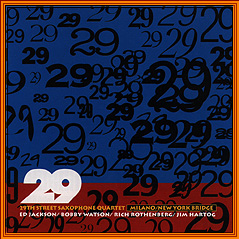 29th Street Saxophone Quartet
29th Street Saxophone Quartetfirst came together for a European tour in 1983. The band is composed of Jim Hartog (baritone saxophone), Ed Jackson (alto saxophone), Rich Rothenburg (tenor saxophone), Bobby Watson (alto saxophone). Hartog & Jackson jammed with other N.Y. saxophonists both in and outside Jim Hartog's 29th Street loft apartments. All four are outstanding soloists, but their records are also characterized by "a state of integrated motion", the horns threading together in quick-fire counterpoint or complex rhythmic interweavings. Their albums include Pointillistic Groove (1984), Watch Your Step (1985), The Real Deal (1989), Underground (1991), Your Move (1992), and Milano/New York Bridge (1994) Colin Larkin (ed.), Encyclopedia of Popular Music 3rd Edition, Volume 7, Muze UK Ltd., New York, 1998, p. 5543 | ||||||||
| 204) |
Track 29 appears in the first stanza of
Chattanooga Choo-Choo in the 1941 song by Mack Gordon with music by Harry Warren (Lyrics & Chords) "Chattanooga Choo-Choo" Pardon me boy, is that the Chattanooga Choo-Choo Yes, yes, track twenty-nine, boy you can give me a shine Can you afford to board the Chattanooga Choo-Choo I got my fare, and just a trifle to spare You leave the Pennsylvania Station 'bout a quarter to four Read a magazine and then you're in Baltimore Dinner in the diner, nothing could be finer Than to have your ham and eggs in Carolina When you hear the whistle blowing eight to the bar Then you know that Tennessee is not very far Shovel all your coal in, gotta keep a-rollin' Whoo whoo, Chattanooga, there you are or some kind of neighborhood There's gonna be a certain party at the station Satin and lace, I used to call funny-face She's gonna cry until I tell her that I'll never roam So, Chattanooga Choo-Choo, won't you choo-choo me home Chattanooga, Chattanooga, get aboard Chattanooga, Chattanooga, all aboard Chattanooga, Chattanooga Chattanooga Choo-Choo, won't you choo-choo me home Chattanooga Choo-Choo | ||||||||
| 205) |
On 29th street appears in a song
"Something
to Brag About" by Tammy Wynette and George Jones from the album 16 Biggest Hits: So let's get married In the not-to-distant future We'll rent a little flat On 29th street Complete Lyrics) | ||||||||
| 206) |
Highway 29
is a song by Bruce Springsteen: The winter sun, shot through the black trees I told myself it was all something in her But as we drove I knew it was something in me Something had been comin' for a long long time And something that was here with me now On highway 29 (Complete Lyrics) | ||||||||
| 207) |
 Number 17 is a 63-minutes B&W film (1932)
Number 17 is a 63-minutes B&W film (1932)Directed by Alfred Hitchcock; Screenplay: Joseph Jefferson Farjeon Plot: A gang of thieves gather at a safe house following a robbery, but a detective is on their trail. Cast: Leon M. Lion, Anne Grey, John Stuart, Donald Calthrop Review | ||||||||
| 208) |
Seventeen
(1940) is a 78-minutes B&W Paramount film directed by Louis King. Cast: Jackie Cooper, Betty Field, Otto Kruger, Ann Shoemaker The film was adapted from the book Seventeen by Booth Tarkington, Harper & Brothers, NY, 1932, 303 pp. Plot: Willy Baxter is now 17, which is practically 18, so he prefers "William". William is supposed to be studying for college entrance exams. Richard Bertrand Dimmitt, A Title Guide to the Talkies, The Scarecrow Press, New York, 1965, p. 1527. | ||||||||
| 210) |
 Seventeen Again is a 97-minutes color film (2000)
Seventeen Again is a 97-minutes color film (2000)Directed by Jeffrey W. Byrd; Screenplay by Stewart St. John. Cast: Tia Mowry, Tamera Mowry Mark Taylor, Tahj Mowry Plot: Cat and Gene have been divorced for several years. They are both visiting their son and their grandchildren. (Review) | ||||||||
| 211) |
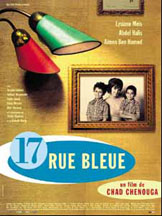 17 rue Bleue is a 95-minutes French film (2001)
17 rue Bleue is a 95-minutes French film (2001)Directed by Chad Chenouga; Screenplay by Chad Chenouga & Philippe Donzelot. Cast: Lysiane Meis, Abdel Halis, Aimen Ben Ahmed. Plot: Fun-loving Adda, an attractive and confident woman, has a comfortable life at 17 rue Bleue thanks to a successful, but married, man. He lovingly sets up a new home, providing for her and her two young sons, one of which is his own. | ||||||||
| 212) |
17th Motion Picture Academy Awards (Oscars) in 1944: Best Picture: Going My Way, Warner Brothers Best Director: Leo McCarey, Going My Way Best Actor: Bing Crosby, Going My Way Best Actress: Ingrid Bergman, Gaslight Supporting Actor: Barry Fitzgerald, Going My Way Supporting Actress: Ethel Barrymore, None But the Lonely Heart The World Almanac and Book of Facts (2006), p. 295 | ||||||||
|
17th Ranking in Lists
| |||||||||
| 213) |
98.5WNCX, Cleveland's Classic Rock radio station
has ranked the Top 98 LP albums Who's Tommy (1969) was selected as the 29th Greatest LP. (#1. Pink Floyd, "Dark Side of the Moon", #2. "Led Zepplin 4", #3. Beatles, "White Album") | ||||||||
| 214) |
Billboard's
Top 100 Rock and Roll Songs of the Fifties has ranked the Top 100 Songs Les Baxter's "Theme from Helen of Troy" (1956) was selected as the 29th Greatest Song. (#1. Elvis Presley, "Don't Be Cruel", #2. Bill Haley and His Comets, "Rock around the Clock", #3. Roger Williams, "Autumn Leaves") | ||||||||
| 215) |
Rolling Stone Magazine's poll of the 500 Greatest Songs of All Time has named The Beatles' Help! (1965) as the 29th Greatest Song. (#1. Bob Dylan "Like a Rolling Stone", #2. Rolling Stones "Satisfaction", #3. John Lennon "Imagine") | ||||||||
| 216) |
Frank Capra's Mr. Smith Goes to Washington (1939) was selected as the 29th best film in AFI's 100 Years... 100 Movies (1998). Plot: A naive man is appointed to fill a vacancy in the US Senate. His plans promptly collide with political corruption, but he doesn't back down. The film starred James Stewart, Jean Arthur, Claude Rains, and Harry Carey. Lewis R. Foster won an Oscar for Best Writing, Original Story (1940). | ||||||||
| 217) |
An Officer and a Gentleman (1982)
was selected as the 29th best love stories film in AFI's 100 Years... 100 Passions (2002). Directed by Taylor Hackford, the film starred Richard Gere and Debra Winger. | ||||||||
| 218) |
The Shining (1980)
was selected as the 29th best thriller film in AFI's 100 Years... 100 Thrills (2001). Based on a Stephen King novel, the film was directed by Stanley Kubrick. The film starred Jack Nicholson, Shelley Duvall, and Danny Lloyd. | ||||||||
| 219) |
This Is Spinal Tap (1984)
was selected as the 29th funniest film in AFI's 100 Years... 100 Laughs (2000). Directed by Rob Reiner, the film starred Rob Reiner, Kimberly Stringer, & Chazz Dominguez. | ||||||||
| 220) |
"Born to Be Wild" from the film
Easy Rider (1969) was selected as the 29th best song in AFI 100 Years... 100 Songs (2004). Directed by Dennis Hopper; Music & Lyrics: Mars Bonfire; Performer: Steppenwolf The film starred Peter Fonda, Dennis Hopper, and Jack Nicholson. | ||||||||
| 221) |
"You can't handle the truth!" from the film
A Few Good Men (1992) was selected as the 29th greatest movie quotes in AFI's 100 Years... 100 Movie Quotes (2005). Directed by Rob Reiner, the film starred Tom Cruise, Jack Nicholson, Demi Moore, & Kevin Bacon. | ||||||||
| 222) |
In the KDFC 2006 Top #100 Classical All-Star Music Poll, Mozart's Magic Flute was selected as the 29th musical piece (Aired January, 2006) (Musical Piece #28: Copland, Appalachian Spring; #30: Mahler, Adagietto) (Top pieces: Beethoven's Symphony #9, Rachmaninoff's Piano Concerto #2, Beethoven's Symphony #6 Pastoral; Top composers: Beethoven, Mozart, Bach; Top performers: Yo Yo Ma, Itzhak Perlman, James Galway) | ||||||||
| 223) |
In the book Sporting News Selects
Baseball's 100 Greatest Players (1998), Napoleon Lajoie, of the Philadelphia Phillies & Athletics and Cleveland Indians was ranked the 29th best baseball player of all time. He won the 1st triple crown, with the highest record .426 batting average (1901). (#1 Babe Ruth; #2 Willie Mays; #3 Ty Cobb; #4 Walter Johnson) | ||||||||
| 224) |
In the book Sporting News Selects
Football's 100 Greatest Players (1999), Roger Staubach of the Dallas Cowboys was ranked the 29th best football player of all time. (#1 Jim Brown; #2 Jerry Rice; #3 Joe Montana; #4 Lawrence Taylor) | ||||||||
| 225) |
In the book
1,000 Years, 1,000 People: Ranking the Men and Women Who Shaped the Millennium by Agnes Hooper Gottlieb, Henry Gottlieb, Barbar Bowers, Brent Bowers (1998), William the Conqueror was ranked the 29th most influential person of the millennium 1001-2000. (#1 Johannes Gutenberg; #2 Columbus; #3 Martin Luther; #4 Galileo) | ||||||||
| 226) |
Ohio State University
was ranked as the 29th largest library (5,087,336 volumes) in a listing of "The 100 Largest Libraries in the United States" (1999). (#1 Library of Congress; #2 Harvard University; #3 New York Public Library; #4 Yale University) 2003 Listing: #29 Los Angeles Public Library (5,554,904 volumes) (#1 Library of Congress; #2 Harvard University; #3 Boston Public Library; #4 Chicago Public Library) | ||||||||
| 227) |
In Martin Seymour-Smith's book
The 100 Most Influential Books Ever Written: The History of Thought from Ancient Times to Today (1998), Thomas Aquinas's Summa Theologiae (1266-1273) was listed as the 29th book in chronological order among the 100 most influential books in the history of thought. | ||||||||
| 228) |
In Henry Miller's
The Books in My Life (1969) Feodor Dostoievsky's works was listed as the 29th book in author alphabetical order among the 100 most influential books that Henry Miller has read. | ||||||||
| 229) |
In
The Internet Top 100 Science Fiction/Fantasy List (July 6, 2003) Lord of Light by Roger Zelazny was ranked as the 29th most popular book. (#1 George R. Martin, A Song of Ice and Fire; #2 J.R.R. Tolkien, Lord of the Rings; #3 Lois M. Bujold, The Vorkosigan Series) | ||||||||
| 230) |
Chicago, USA was ranked as the 29th most populous city (6,945,000) in Top 100 Cities of the World— ranked by population. (#1 Tokyo, Japan; #2 Mexico City, Mexico; #3 Mumbai, India; #4 Sáo Paulo, Brazil) | ||||||||
| 231) |
Spain was ranked as the 29th most populous country (39,208,236) in Top 100 Countries of the World— ranked by population. (#1 China; #2 India; #3 United States; #4 Indonesia; #5 Brazil) | ||||||||
| 232) |
"By" was ranked as the 29th most used English word in The First 100 Most Commonly Used English Words from The Reading Teacher's Book of Lists (4th Ed., 2000) by Edward Bernard Fry, Jacqueline E. Kress, & Dona Lee Fountoukidis (#1 the, #2 of, #3 and, #4 a, #5 to, #6 in, #7 is, #8 you, #9 that, #10 it) In a survey of The 500 Most Commonly Used Words in English "by" was ranked as the 29th most commonly used English word. | ||||||||
| 233) |
In The Modern Library 100 Best Novels (2003). Board's List 29th best novel: James T. Farrell's The Studs Lonigan Trilogy (#1 James Joyce, Ulysses; #2 F. Scott Fitzgerald, The Great Gatsby) Reader's List 29th best novel: Stephen King's The Stand (#1 Ayn Rand, Atlas Shrugged; #2 Ayn Rand, The Fountainhead) | ||||||||
| 234) |
In The Modern Library 100 Best Nonfiction (2003). Board's List 29th best nonfiction: Ernest H. Gombrich's Art and Illusion (#1 Henry Adams, The Education of Henry Adams; #2 William James, Varieties of Religious Experience) Reader's List 29th best nonfiction: Frances Yates' The Art of Memory (#1 Ayn Rand, Virtue of Selfishness; #2 L. Ron Hubbard, Dianetics) | ||||||||
| 235) |
29th best-loved novel is John Steinbeck's The Grapes Of Wrath in BBC's Big Read: Top 100 (April 2003). #28 John Irving's A Prayer for Owen Meany; #30 Lewis Carroll's Alice's Adventures In Wonderland (#1 JRR Tolkien, Lord of the Rings; #2 Jane Austen, Pride and Prejudice) | ||||||||
| 236) |
29th most popular book downloaded is Emile Cammaerts' Through the Iron Bars in Project Gutenberg's Top 100 (2-12-2006). #28 A. M. Williamson & C. N. Williamson's Rosemary; #30 Charles Seignobos's History Of Ancient Civilization (#1 Sarah Knowles Bolton, Lives of Girls Who Became Famous; #2 Notebooks of Leonardo da Vinci; #3 Vatsyayana Kamasutra; #4 Unknown, The Illustrated Alphabet of Birds) | ||||||||
| 237) |
The Fortune 500 is a ranking of the top 500 United States public corporations as measured by gross revenue. In 2006, the 17th Ranking was J.P. Morgan Chase & Co. with revenue of $79,902 million (#16: McKesson; #18: Verizon Communications) (#1 Exxon Mobil; #2 Wal-Mart Stores; #3 General Motors; #4 Chevron; #5 Ford Motor) | ||||||||
| 238) |
Forbes Top 100 Celebrity Ranking (6-15-2005):
Power #29:
Shania Twain (#1 Oprah Winfrey, #2 Tiger Woods, #3 Mel Gibson) Pay #29: Tobey Maguire (#1 George Lucas, #2 Oprah Winfrey, #3 Mel Gibson) Web #29: Bette Midler (#1 Bill Clinton, #2 Oprah Winfrey, #3 George Lucas) | ||||||||
| 239) |
Malaysia was ranked as the 17th country favored by tourists with 2,959,000 visitors in Tourist Arrivals (#1 France; #2 United States; #3 Spain; #4 Italy; #5 Hungary) George Thomas Kurian, The Illustrated Book of World Rankings, Sharpe Reference, Armonk, NY, 1997, p. 211 | ||||||||
| 240) |
Internet Movie Database was ranked as the 29th most popular web site in Web 100: Top 100 by web100.com (#1 CNET; #2 Shutterfly; #3 ESPN.com; #4 National Geographic Online) | ||||||||
|
17 in the Bible
| |||||||||
| 241) |
29 occurs in the Bible 8 times: And Nahor lived nine and twenty years, and begat Terah: — Genesis, 11.24 (2247 B.C.) All the gold that was occupied for the work in all the work of the holy place, even the gold of the offering, was twenty and nine talents, and seven hundred and thirty shekels, after the shekel of the sanctuary. — Exodus, 38.24 (1491 B.C.) And Lebaoth, and Shilhim, and Ain, and Rimmon: all the cities are twenty and nine, with their villages: — Joshua, 15.32 (1444 B.C.) He [Amaziah] was twenty and five years old when he began to reign, and reigned twenty and nine years in Jerusalem. And his mother's name was Jehoaddan of Jerusalem. — II Kings, 14.2 (842 B.C.) Twenty and five years old was he when he began to reign; and he reigned twenty and nine years in Jerusalem. His mother's name also was Abi, the daughter of Zachariah. — II Kings, 18.2 (678 B.C.) Amaziah was twenty and five years old when he began to reign, and he reigned twenty and nine years in Jerusalem. And his mother's name was Jehoaddan of Jerusalem. — II. Chronicles, 25.1 (840 B.C.) Hezekiah began to reign when he was five and twenty years old, and he reigned nine and twenty years in Jerusalem. And his mother's name was Abijah, the daughter of Zechariah. — II. Chronicles, 29.1 (741 B.C.) And this is the number of them: thirty chargers of gold, a thousand chargers of silver, nine and twenty knives, — Ezra, 1.9 (536 B.C.) The Complete Concordance to the Bible (New King James Version) Thomas Nelson Publishers, Nashville, TN (1983), p. 1004 | ||||||||
| 242) |
Chapter 29 in Genesis: Jacob comes to Haran, meets Rachel, deceived with Leah, works 7 more years for Rachel: 1. Then Jacob went on his journey, and came into the land of the people of the east. 2. And he looked, and behold a well in the field, and, lo, there were three flocks of sheep lying by it; for out of that well they watered the flocks: and a great stone was upon the well's mouth. 6. And they said, He is well: and, behold, Rachel his daughter cometh with the sheep. 11. And Jacob kissed Rachel, and lifted up his voice, and wept. 20. And Jacob served seven years for Rachel; and they seemed unto him but a few days, for the love he had to her. 25. And it came to pass, that in the morning, behold, it was Leah: and he said to Laban, What is this thou hast done unto me? did not I serve with thee for Rachel? wherefore then hast thou beguiled me?. 30. And he went in also unto Rachel, and he loved also Rachel more than Leah, and served with him yet seven other years. — Genesis, 29.1, 2, 6, 11, 20, 25, 30 (1760 B.C.) | ||||||||
| 243) |
Verse 29 of Genesis Chapter 32 After wrestling with the Angel, Jacob was blessed by the Angel: And Jacob asked him, and said, Tell me, I pray thee, thy name. And he said, Wherefore is it that thou dost ask after my name? And he blessed him there.. — Genesis, 32.29 (1739 B.C.) | ||||||||
| 244) |
There are 29 verses in Chapter 29 of
Deuteronomy, Moses asks his people to obey God's covenant: 1. These are the words of the covenant, which the LORD commanded Moses to make with the children of Israel in the land of Moab, beside the covenant which he made with them in Horeb. 2. And Moses called unto all Israel, and said unto them, Ye have seen all that the LORD did before your eyes in the land of Egypt unto Pharaoh, and unto all his servants, and unto all his land; 9. Keep therefore the words of this covenant, and do them, that ye may prosper in all that ye do. 15. But it shall come to pass, if thou wilt not hearken unto the voice of the Lord 29. The secret things belong unto the LORD our God: but those things which are revealed belong unto us and to our children for ever, that we may do all the words of this law. — Deuteronomy 29.1-2, 9, 29 (1451 B.C.) | ||||||||
| 245) |
There are 29 chapters in I. Chronicles. In Chapter 29, David gives thanksgiving to the Lord: 10. Wherefore David blessed the LORD before all the congregation: and David said, Blessed be thou, LORD God of Israel our father, for ever and ever. 11. Thine, O LORD is the greatness, and the power, and the glory, and the victory, and the majesty: for all that is in the heaven and in the earth is thine; thine is the kingdom, O LORD, and thou art exalted as head above all. 13. Now therefore, our God, we thank thee, and praise thy glorious name. Blessed be thou, LORD God of Israel our father, for ever and ever. 18. O LORD God of Abraham, Isaac, and of Israel, our fathers, keep this for ever in the imagination of the thoughts of the heart of thy people, and prepare their heart unto thee: 27. And the time that he reigned over Israel was forty years; seven years reigned he in Hebron, and thirty and three years reigned he in Jerusalem. 28. And he died in a good old age, full of days, riches, and honour: and Solomon his son reigned in his stead. — I. Chronicles 29.10-11, 13, 18, 27-28 (1023 B.C.) | ||||||||
| 246) |
Chapter 29 of Book of Job: Job bemoans himself when he remembers his former prosperity and honour. 2. Oh that I were as in months past, as in the days when God preserved me; 3. When his candle shined upon my head, and when by his light I walked through darkness; 5. When the Almighty was yet with me, when my children were about me; 15. I was eyes to the blind, and feet was I to the lame. 18. Then I said, I shall die in my nest, and I shall multiply my days as the sand. 19. My root was spread out by the waters, and the dew lay all night upon my branch. 23. And they waited for me as for the rain; and they opened their mouth wide as for the latter rain. — Book of Job 29.2-3, 5, 15, 18-19, 23 (1023 B.C.) | ||||||||
| 247) |
In the 29th Psalm, David exhorts princes to give glory to God: 1. Give unto the LORD, O ye mighty, give unto the LORD glory and strength. 3. The voice of the LORD is upon the waters: the God of glory thundereth: the LORD is upon many waters. 4. The voice of the LORD is powerful; the voice of the LORD is full of majesty. 7. The voice of the LORD divideth the flames of fire. 8. The voice of the LORD shaketh the wilderness; the LORD shaketh the wilderness of Kadesh. 11. The LORD will give strength unto his people; the LORD will bless his people with peace. — Psalms 29.1, 3-4, 7-8, 11 (1023 B.C.) | ||||||||
| 248) |
Verse 29 of Matthew Chapter 6: 28. And why take ye thought for raiment? Consider the lilies of the field, how they grow; they toil not, neither do they spin: 29. And yet I say unto you, That even Solomon in all his glory was not arrayed like one of these. — Matthew, 6.28-29 (31 A.D.) | ||||||||
| 249) |
Verse 29 of Matthew Chapter 15: 29. And Jesus departed from thence, and came nigh unto the sea of Galilee; and went up into a mountain, and sat down there. — Matthew, 15.29 (31 A.D.) | ||||||||
| 250) |
Verse 29 of Luke Chapter 13: 29. And they [prophets] shall come from the east, and from the west, and from the north, and from the south, and shall sit down in the kingdom of God. — Luke, 13.29 (31 A.D.) | ||||||||
| 251) |
Verse 29 of Luke Chapter 21: 29. And he spake to them a parable; Behold the fig tree, and all the trees; — Luke, 21.29 (31 A.D.) | ||||||||
| 252) |
Verse 29 of John Chapter 20: 29. Jesus saith unto him, Thomas, because thou hast seen me, thou hast believed: blessed are they that have not seen, and yet have believed. — John, 20.29 (31 A.D.) | ||||||||
| 253) |
29th Book of Ecclesiasticus: On Loans, Generosity, Securities, Home & Hospitality—
Nevertheless, be patient with those who are badly-off, do not keep them waiting on your generosity. For the commandment's sake go to the poor man's help, do not turn him away empty-handed in his need. Better let your silver go on brother or friend, do not let it go to waste, rusting under a stone. Invest your treasure as the Most High orders, and you will find it more profitable than gold. Deposit generosity in your storerooms and it will release you from every misfortune. Better than sturdy shield or weighty spear, it will fight for you against the enemy. — Ecclesiasticus XXIX.11-17 (circa 280 B.C.) The Jerusalem Bible (Editor, Alexander Jones) Doubleday & Co., Garden City, NY, 1967, pp. 936-937 | ||||||||
| 254) |
29th Book of Enoch describes Further Journey to the East:
And thence I went to another place in the desert, and approached to the east of this mountain range. And there I saw aromatic trees exhaling the fragrance of frankincense and myrrh, and the trees also were similar to the almond tree. — Book of Enoch XXIX.1-2 (circa 105 B.C.-64 B.C.) translated by R. H. Charles, S.P.C.K., London, 1917, p. 53 | ||||||||
| 255) |
29th Saying of
Gospel of Thomas (circa 150 A.D.): Jesus said, "If the flesh came into being because of spirit, that is a marvel, but if spirit came into being because of the body, that is a marvel of marvels. Yet I marvel at how this great wealth has come to dwell in this poverty. Gospel of Thomas, Saying #29 (114 Sayings of Jesus) (trans. Marvin Meyer, 1992; adapted by Elaine Pagels, Beyond Belief, pp. 231-232) Nag Hammadi Library, Ed. James M. Robinson, trans. Thomas O. Lambdin, 1988, p. 130 | ||||||||
| 256) |
29th Section of
The (First) Apocalypse of James (circa 150 A.D.): James said, "Rabbi, how, after these things, will you appear to us again? After they seize you, and you complete this destiny, you will go up to Him-who-is." The Lord said, "James, after these things I shall reveal to you everything, not for your sake alone but for the sake of the unbelief of men, so that faith may exist in them. For a multitude will attain to faith and they will increase." The (First) Apocalypse of James, Section #29 Nag Hammadi Library, Ed. James M. Robinson, translated by William R. Schoedel, 1988, p. 264 | ||||||||
| 257) |
29th Section of
The Sentences of Sextus (circa 150 A.D.): Strive eagerly to be victorious over every man in prudence; maintain self-sufficiency. You cannot receive understanding unless you know first that you possess it. It is better to serve others than to make others serve you. The Sentences of Sextus, Section 29, Sentences #332-333, 336 Nag Hammadi Library, Ed. James M. Robinson, translated by Frederik Wisse 1988, pp. 505-506. | ||||||||
| 258) |
Chapter 29 in the First Book of
Pistis Sophia (circa 150 A.D.): Now it happened after these things I came to the height to the veils of the thirteenth aeon. Now it happened that when I reached their veils, they drew themselves and they opened to me. I entered into the thirteenth aeon, I found the Pistis Sophia below the thirteenth aeon alone, none of them being with her. But she dwelt in that place, sorrow and grieving because she had not been taken to the thirteenth aeon, her place in the height. And furthermore she was sorrowful on account of the torments which the Authades inflicted on her, he being one of the three triple- powered ones. But when I tell you about their extent, I will tell you the mystery of how these things happened. Now it happened, when the Pistis Sophia saw me shining exceedingly, there being no measure to the light which I had, she was in great agitation and she looked at the light of my garment. She saw the mystery of her name in my garment and the whole glory of its mystery because she was previously in the place of the height in the thirteenth aeon. But she was wont to sing praises to the light in the height which she saw in the veil of the Treasure of the Light. It happened now when she continued to sing praises to the light in the height, all the archons, which are with the two great triple-powered ones, looked on, and also her invisible one which is paired with her, and the other 22 invisible emanations— since the Pistis Sophia with her partner, with the other 22 emanations make up the 24 emanations , which the great invisible forefather with the two great triple-powered ones has emanated." Pistis Sophia, Chapter 29 (Translated by Violet MacDermott, Edited by Carl Schmidt, Nag Hammadi Studies, IX: Pistis Sophia, E. J. Brill, Leiden, 1978, pp. 84-85) | ||||||||
| 259) |
Chapter 29 of
Books of Jeu (circa 200 A.D.): And there are twelve heads in his treasury; that is, the names are these which are in the places. And there are twelve in each rank, and this name is that of the twelve, except for those that will be in them, when they sing praises to my Father, so that he gives light-power to them. These are they which... emanated forth when the power of my Father radiated within him. He emanated twelve emanations. And there are twelve heads in each emanation, and this name is that of the twelve; and there are twelve in each one of the ranks, and they are one outside the other endlessly, these being their names, except for their watchers. The three watchers; ... ... ... Books of Jeu Ch. 29 (Translated by Violet MacDermott, Edited by Carl Schmidt, Nag Hammadi Studies, XIII: The Books of Jeu, E. J. Brill, Leiden, 1978, p. 77) | ||||||||
| 260) |
Chapter 29 of
Aquarian Gospel has 29 verses of Jesus in India. Ajainin, a priest from Lahore, comes to Benares to see Jesus: 5. But Jesus said to them, The light is most abundant, and it shines for all; if you would see the light come to the light. 6. If you would hear the message that the Holy One has given me to give to men, come unto me. 11. And Jesus said, The Holy One regards all men alike; the dwelling of my host is good enough for any council of the sons of men. 13. Your presents I return; you cannot buy the knowledge of the Lord with gold, or precious gifts. 16. And Jesus said, There is no night where shines the sun; I have no secret messages to give; in light all secrets are revealed. 19. And Jesus said, This kingdom is not far away, but man with mortal eyes can see it not; it is within the heart. 20. You need not seek the king in earth, or sea, or sky; he is not there, and yet is everywhere. He is the Christ of God; is universal love. 29. Now, in Benares Jesus tarried many days and taught. The Aquarian Gospel of Jesus the Christ, Chapter 29.29 Transcribed from the Akashic Records by Levi H. Dowling DeVorss & Co., Santa Monica, CA, 1908, Reset 1964, pp. 65-67 | ||||||||
On the Number 29: Section 2— Philosophy, Religion & Poetry
![]()
| Top of Page
| Poem #29
| Numbers
| Dates
| A-Z Portals |
| Birthdays
| Books
| Enlightenment
| Poetry
| Home |
![]()
| © Peter Y. Chou, WisdomPortal.com P.O. Box 390707, Mountain View, CA 94039 email:  (2-27-2006) (2-27-2006) |
 |
.jpg)



